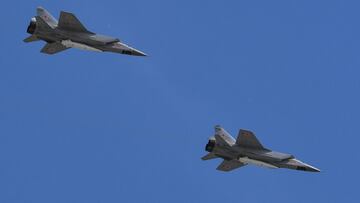What are hypersonic missiles, how do they work and why has Russia used them in Ukraine?
Russia has confirmed it has deployed Kinzhal missiles in Ukraine against military targets, hypersonic weapons that are practically impossible to stop.

Russia’s Ministry of Defence confirmed last Saturday that the Kremlin had approved the use of Kinzhal hypersonic missiles against military targets in Ukraine. The Defence Ministry said the hypersonic weapons had been used to destroy a “large underground warehouse of missiles and aviation ammunition” in Deliatyn, in eastern Ukraine. A day later, further Kinzhal attacks were launched against a military base in the Zhytomyr region of Ukraine’s northwest, which Russian officials said was occupied by over 100 Ukrainian special forces troops and “foreign mercenaries.” The US confirmed the use of Kinzhals in Ukraine after tracking the strikes in real time. The attacks represent the first time Russia has admitted deploying hypersonic missiles in combat, although it is suspected they have been used in Syria.
BREAKING: G-7 leaders plan to warn Russian President Vladimir Putin against using chemical or nuclear weapons in Ukraine https://t.co/KVwMDY1mYI pic.twitter.com/my9GelcVrl
— Bloomberg Quicktake (@Quicktake) March 24, 2022
What is a Kinzhal?
The Kh-47M2 Kinzhal was unveiled by Russian President Vladimir Putin in 2018 as one of a range of “new generation” weapons developed in response to the decision of the United States to pull out of the 1972 Anti-Ballistic Missile Treaty, which until its dissolution in 2002 had been the basis of the nuclear non-proliferation agreement between the two Cold War superpowers. A hypersonic missile, the Kinzhal has a range of over 1,200 miles and can reach speeds of Mach 10: 7,600mph or 10 times faster than the speed of sound. By comparison, a US Air Force F-35A has a top speed of Mach 1.6, or 1,200mph. Russia claims that its range can be extended to over 1,800 miles if delivered from a Tupolev Tu-22M strategic bomber.
The Kinzhals launched against targets in Ukraine were fired from modified supersonic MiG-31s and, according to military experts, the missiles are extremely difficult to defend against. They have a high level of manoeuvrability and reach Mach 4 rapidly after launch, making most missile defence systems and airborne interceptors redundant.
“Russia has just launched the hypersonic missile, because it's the only thing that they can get through with absolute certainty,” US President Joe Biden was quoted by CNN as saying on Monday. “It's a consequential weapon ... it's almost impossible to stop it. There's a reason they're using it.”
Video making the rounds this am, reports that it is first combat use of Russian hypersonic missile - Kinzhal on a weapons depot near the Polish border pic.twitter.com/pVxqEWlT5J
— Jack Posobiec 🇺🇸 (@JackPosobiec) March 19, 2022
What does the use of hypersonic weapons mean in the wider context?
Related stories
The issue that has the western powers concerned is what the Kinzhal is capable of carrying. The hypersonic missiles are able to deliver either a conventional or nuclear payload of up to 480kg. According to defence and aerospace industry experts defenseworld.net, that is equivalent to 33 times the power of devastation of the atomic bomb dropped on Hiroshima in 1945.
Another concern for the US, NATO and the western allies is that although the Kinzhal is extremely accurate, the strikes last weekend were carried out against targets not far from Ukraine’s borders with NATO members Romania and Poland. While such systems are hugely reliable, were a Russian launch to strike NATO territory there would be swift retaliation. However, US Defense Secretary Lloyd Austin told CBS’ Face the Nation last Sunday that Putin “is trying to re-establish some momentum” as Russia’s ground assault has failed to make the breakthroughs anticipated by the Kremlin. US officials also believe that Russia is “sending a message” to the western allies by launching Kinzhals, while also taking advantage of the opportunity to battle test the armaments. “It’s a bit of a head-scratcher... Why you would need a hypersonic missile fired from not that far away to hit a building?” a senior Pentagon official told CNBC.


